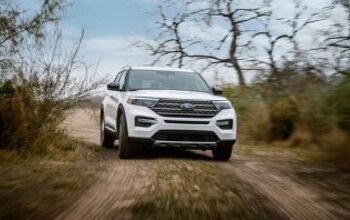As Pedestrian Deaths Spike, Safety Group Puts the Spotlight on SUVs

We’ve already told you that, while traffic fatalities dropped in 2017, pedestrians deaths showed the opposite trend. Now, preliminary data from 2018 suggests pedestrians deaths rose to their highest point since 1990 last year, and one group claims high-riding crossovers and SUVs are a big part of the problem.
How big? According to the Governors Highway Safety Association, pedestrian fatalities involving SUVs rose 50 percent in the past five years.
Drawing its data from State Highway Safety Offices, the GHSA claims the estimated 6,227 pedestrian fatalities in 2018 represents a 4 percent increase from 2017. Data from the National Highway Traffic Safety Administration shows the same type of fatality rose 35 percent from 2008 to 2017, with motorist and motorcyclist deaths down 6 percent in the same time frame.
Are SUVs, crossovers, and pickups solely to blame for the carnage? Absolutely not. As the average age of an American vehicle is 11 years, there’s still plenty of vehicles with trunks, new and old, piloting the country’s roadways. And passenger cars still represent the largest share (42 percent) of vehicles involved in a fatal pedestrian collision (2,279 in 2017, versus an SUV figure of 1,079). Still, the balance is tilting more heavily towards light trucks as the years progress, and with good reason.
In 2013, 50.1 percent of new vehicles sold in the U.S. were light trucks. Five years later, the take rate was 68.2 percent. The diverging trends in pedestrian and motorist deaths can be attributed to that fact that, as vehicles get safer for occupants, human beings haven’t grown more resilient to 4,000-pound vehicle impacts. And the taller the vehicle, the more likely a struck pedestrian will die.
Combined, the number of single-vehicle pedestrian fatalities linked to pickups, crossovers, and SUVs in 2017 (2,023) nearly reaches that of cars.
While the 50 percent increase in light truck-related pedestrian deaths looks bad, during the same five-year span pedestrian fatalities caused by passenger cars rose 30 percent. Hardly blameless in the rise in fatalities.
So what’s to blame for the rise in deaths? Vehicle type is one factor, but an increase in the total number of miles driven doesn’t help, nor does the population boom in major urban centers. That’s where people are moving, and that’s where an increasing number of vehicles exist. NHTSA data shows a steep increase in the number of urban vehicle miles driven in the past decade, with a corresponding decrease in rural miles.
Motorists are increasingly hitting more pedestrians at night, with the 45 percent increase in deaths during dark hours standing in stark contrast to the 11 percent daylight increase seen between 2008 and 2017. Some 75 percent of pedestrian fatalities occur at night. As for location, 72 percent of pedestrian deaths took place between intersections, away from marked crossings and signals.
While alcohol impairment as a factor in vehicle collisions dropped to its lowest point since (at least) 1982 in 2017, booze remains a big factor in pedestrians deaths. Some 17 percent of drivers involved in a pedestrian fatality were above the legal blood alcohol limit, while, on average, legally drunk pedestrians made up 32 percent of 2017’s fatalities. Victims in age groups ranging from 21 to 54 are most likely to be impaired, with no group in that range falling below 40 percent.
These numbers do not include drug impairment, which would only skew the overall impaired numbers higher (to what degree is hard to say). The most common drug associated with pedestrian deaths is methamphetamine.
Nearly half — 46 percent — of pedestrian deaths in the first half of 2018 came from five states: California, Arizona, Texas, Florida, and Georgia. Together, they punch above their weight in terms of pedestrian deaths, as they contain only 33 percent of the country’s population. The state with the highest fatality rate is New Mexico, with 3.53 pedestrian deaths per 100,000 residents in 2017.
While distracted driving and walking did not factor into the GHSA’s report, no one would argue that it’s an issue on the decline. Dealing with that problem won’t be an easy fix, either. Nor will fixing the state of America’s roads. Adding mid-block crossing signals, improving both street and vehicle lighting, and numerous other infrastructure enhancements would help bring the number of deaths lower, but that takes time, money, and conviction on the part of city and state lawmakers.
Mandating automatic emergency braking with pedestrian detection would probably help to some degree, but it won’t do anything for the legions of older vehicles plying our roads. Plus, as we saw in early IIHS testing, these systems are certainly not all made equal.
[Image: General Motors, Honda]

More by Steph Willems
Latest Car Reviews
Read moreLatest Product Reviews
Read moreRecent Comments
- ToolGuy TG likes price reductions.
- ToolGuy I could go for a Mustang with a Subaru powertrain. (Maybe some additional ground clearance.)
- ToolGuy Does Tim Healey care about TTAC? 😉
- ToolGuy I am slashing my food budget by 1%.
- ToolGuy TG grows skeptical about his government protecting him from bad decisions.



































Comments
Join the conversation
Conservation of momentum always works out heavily in favor of the vehicle independent of the size of the vehicle. With either a Fiat 500 or a Cadillac Escalade, the pedestrian is going to lose. What matters is the pedestrian not stepping out in front of the car.
It doesn’t help that government planning is pushing people to walk and bike everywhere when the last 30 years people have been used to driving anything over half a mile away.